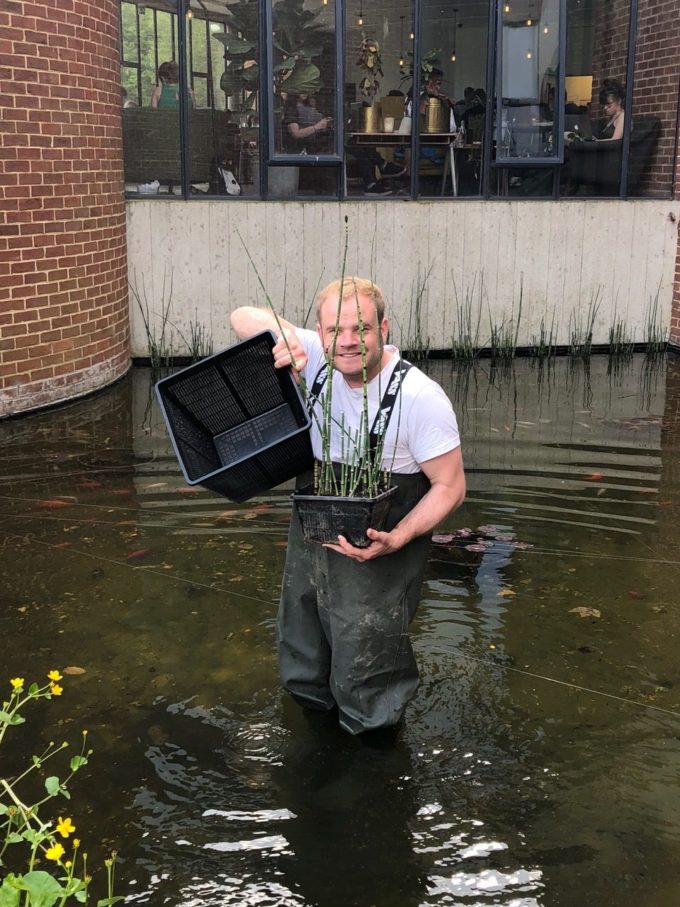
We speak to Ben Woodward, Company Director of Universal Aquaculture Limited, to learn more about the decisions that go into the careful task of managing our Attenborough Centre for the Creative Arts pond.
Looking Deep into Shallow Water
Great architects and landscape gardeners have realised the importance of water being incorporated into design for centuries. Water can represent any shape it is put into, the Chinese base a lot of martial arts on the idea that one must be as close to water as possible. Indeed if you put water into a tea pot it becomes the shape of the tea pot. On a greater scale rivers uncoil as they get to the sea like a python, water cannot only be silent and still but it can be a deep roaring torrent or the waves on the beach can send us a chorus of voices. Even though water can be all of the above, it is easily tamed and controlled when used on purpose in manmade environments.
In design water can be used as a sign of power such as a moat on the medieval castle reflecting the building and making it look twice the size and height. It can be used to enhance tranquillity as is the case in Monet’s garden in Giverny. It is also used to breathe life into vast landscapes as Lancelot ‘Capability’ Brown often did with his landscape architecture. Looking into the distance of a Brown garden over the lake, the seasons seem to appear more defined, the lake at the bottom of Kimberley Hall’s estate uses the Autumn mist as a duvet as it prepares for the surface to become ephemeral ice and lock away the secrets under the murky surface until springs capricious air breathes life back into the water. It is almost as though the ancient Greeks were correct in assuming Persephone was returning to earth and with it bringing back the abundance of nature the spring and summer has to offer us.
In the case of Sir Basil Spence (the University of Sussex architect) he incorporated water in a bid to soften what is describe as ‘brutalist architecture’ making his moats/water features an integral part of the buildings he designed.
The team at ACCA realised how important this element was in the renovation of the building and decided to reinstate the moat to not only its former glory but surpassing the technologies that were available at the time to make sure the water remains healthy and clear; if you compare the quality and clarity of the water at ACCA to the other ponds on campus it is clearly far superior to anything on site.
Circles and curves are typically the weakest structures when using concrete and brickwork so typically large buildings constructed with traditional methods (such as ACCA) will move. Seeing as water can escape through pin holes the original pond cracked causing leaks due to the movement of the building.
When we were asked to come aboard on the project to renovate the pond, it was exciting and always great to be involved with grade listed buildings. The first thing we wanted to make sure is that whatever we did we wanted it to stay as close to how Sir Basil Spence desired. This meant making sure whatever materials we used and whatever equipment was needed to keep clear was kept hidden.
The water proofing of the pond has been done in layers, we repaired cracks, rendered the walls and the floor, then we added three layers of fibreglass to waterproof it. It is kept clear by a bespoke filtration system which is located in an underground chamber in front of the pond – again hidden so to create zero impact on the building itself. The water is pumped into the underground chamber and is fed through a series of filters including an ultraviolet light system to kill the unicellular algae which causes green water.
We are going to be planting the pond up when the weather stabilises for summer and the pond will begin to look better than it ever has. As part of the maintenance regime the water quality is regularly tested and it has never been any less than perfect since the new system and maintenance regime was implemented – this makes for happy fish, healthy plants and the reflection that Sir. Basil Spence once dreamed of becoming a reality. Without the modern technology we have today to install low impact high efficiency filters he would have seen the pond turn green and it would have been emptied and refilled for events. The beauty of the new system is a huge saving in water, it will rarely if ever need completely emptying, providing the maintenance is kept up to date the water will remain clear and healthy for years to come and the look of the pond as the plants mature will always improve.
The water will provide not only a place for the buildings reflection but for the quiet reflection and contemplation of those who choose to put down their modern distractions and enjoy being around the water, to be in the moment, to be around something that allows the sunlight to dance on its surface and for us to stare whimsically through its waves, after all we are made up of around 60 percent of the stuff.